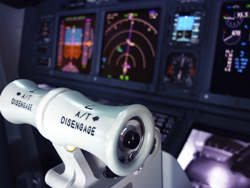Aircraft design tools to avoid dangerous phenomena
When coupling-related instabilities exceed the structural strength limits of the aircraft, consequences can be catastrophic. Accumulating data suggests that modern designs with increasing automation of the flight control systems are particularly susceptible to these aircraft–pilot couplings and rotorcraft–pilot couplings (A/RPCs). As automation will continue to increase, scientists sought to eliminate A/RPCs through work conducted for the EU-funded project 'Aircraft and rotorcraft pilot couplings – Tools and techniques for alleviation and detection' (ARISTOTEL) . Team members developed guidelines for simulations of the vehicle-pilot-flight control system dynamics for both rigid body (vehicle frequencies of 0 to 2 Hz) and aeroelastic (2 to 8Hz) conditions. Researchers also developed guidelines to help predict initiation of A/RPCs early in the design cycle and during flight simulator testing. The European Commission has set a goal to reduce aviation accidents by 80% by 2020. With increasing automation of aircraft leading to increasing likelihood of unfavourable aircraft–pilot couplings and loss of control, the development of technologies to eliminate this growing problem is imperative. The ARISTOTEL project directly addressed enhancement of aviation safety for both rotorcraft and fixed-wing aircraft. New models and design tools to accurately predict development of A/RPCs will improve designs to ensure safety while reducing time and costs. In addition, they will foster inclusion of A/RPC standards in rotorcraft certification processes, something not possible until now due to lack of suitable evaluation methods. Overall, ARISTOTEL has made a valuable contribution to passenger and crew safety during air travel that will become increasingly important with increasing automation of aircraft.
Keywords
Aircraft–pilot coupling, rotorcraft–pilot coupling, flight control system, simulation, design tool







